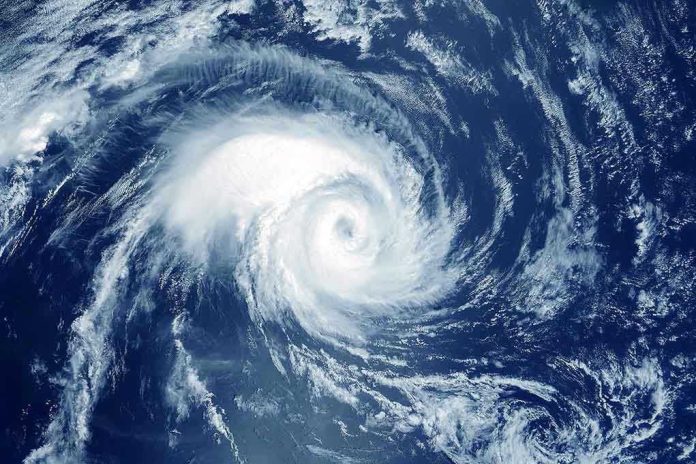
When a nation battered by one deadly storm braces for another, survival becomes a test of collective will and the limits of human resilience.
Story Highlights
- Back-to-back typhoons have left millions in the Philippines reeling, with Super Typhoon Fung-wong striking just days after deadly Typhoon Kalmaegi.
- Fung-wong intensified rapidly, reaching a record size and forcing the evacuation of over one million people before landfall.
- Disaster response systems face unprecedented strain as resources are stretched thin and government enacts a national state of calamity.
- The compounded crises expose the Philippines’ vulnerability, highlighting urgent calls for long-term resilience and adaptation.
Super Typhoon Fung-wong: A Relentless Test for a Weary Nation
November 2025 unleashed a scenario that disaster planners dread and survivors never forget: the Philippines, still counting its dead and scrambling for relief after Typhoon Kalmaegi, was forced to confront the oncoming monster of Super Typhoon Fung-wong. Fung-wong—locally called Uwan—didn’t just threaten; it dwarfed. At peak, the storm stretched 1,800 kilometers across, a record for the Pacific season, and powered up at a velocity meteorologists called “explosive.” The archipelago’s battered landscape braced for a second wave of devastation, its people facing evacuation orders with barely time to mourn or rebuild.
As the eye of Fung-wong closed in on Luzon, authorities issued the highest level of disaster alert. The government declared a national state of calamity on November 6, days before landfall, a move that underscored both the scale of the threat and the urgency of the moment. Over one million residents, many already displaced by Kalmaegi, were moved from their homes—some for the second time in a week. Airports and seaports shut down. Schools and government offices fell silent, their halls repurposed for relief operations. In the provinces of Aurora and Bicol, the storm’s impact was immediate: surging rivers, roofs torn away, and power lines felled like matchsticks.
Compound Disaster: The Anatomy of Strain and Scramble
Typhoon Kalmaegi had already exposed the Philippines’ persistent vulnerabilities: 224 dead, central regions in ruins, and communities struggling for water, food, and shelter. The arrival of Fung-wong compounded every challenge. Local officials, some still overseeing funerals and emergency shelters, now faced the logistical nightmare of mass evacuation and resource reallocation. Emergency teams from the military, police, and coast guard fanned out, many working on little sleep and less certainty. Health and social welfare agencies set up mobile clinics and distributed relief packs, but the sheer scale—millions at risk, thousands already homeless—meant needs always outpaced supplies.
Coordination between local and national government became a high-wire act. The president’s office directed policy, but execution fell on mayors, barangay captains, and the countless volunteers who formed the backbone of response. The National Disaster Risk Reduction and Management Council (NDRRMC) and PAGASA, the weather bureau, issued round-the-clock updates, while the Department of the Interior and Local Government (DILG) ordered all officials to remain in their posts. For families huddled in evacuation centers, the crisis was personal: where to find clean water, how to care for elderly relatives, and when—if ever—they could return home.
Immediate Impact and Unfolding Consequences
When Fung-wong made landfall in Dinalungan, Aurora on November 9, its winds exceeded 240 km/h, flattening everything in its path. Initial reports tallied eight dead and fifteen injured, with numbers expected to climb as communications were restored. Floodwaters cut off towns, landslides buried roads, and power outages spread across Luzon and Visayas. The government suspended classes and public work, essentially pausing daily life for millions. Yet, even as the storm raged, the machinery of response pressed on—rescue boats ferried stranded families, and relief trucks navigated debris-choked highways.
The short-term implications are staggering: more than one million displaced, immediate humanitarian needs in food, shelter, and medical care, and the specter of disease outbreaks in crowded evacuation centers. Longer term, the task of rebuilding grows more daunting with each consecutive disaster. For many, the trauma of repeated loss—of home, livelihood, and loved ones—compounds into a form of disaster fatigue that experts warn will outlast the headlines.
Aftershocks and the Search for Resilience
The Philippines’ status as a typhoon magnet has rarely been so starkly illustrated. In the wake of Fung-wong, calls for systemic change have grown louder: resilient infrastructure, better forecasting tools, and a disaster response apparatus that can withstand more than a single catastrophe before buckling. Climate scientists point to warming oceans and shifting weather patterns as engines of these supercharged storms, warning that the era of back-to-back typhoons may be the new normal. Policymakers face a reckoning—not just to rebuild, but to adapt.
For now, Filipinos draw on reserves of grit and solidarity, supporting one another through the unending cycle of storm and recovery. The nation’s capacity for endurance inspires, but the cost is real—measured not just in damaged property, but in lives interrupted and futures made fragile. The world watches, and for the Philippines, the hard questions only intensify: how many more storms can a country weather before the cycle finally breaks?
Sources:
Wikipedia: Typhoon Fung-wong (2025)









